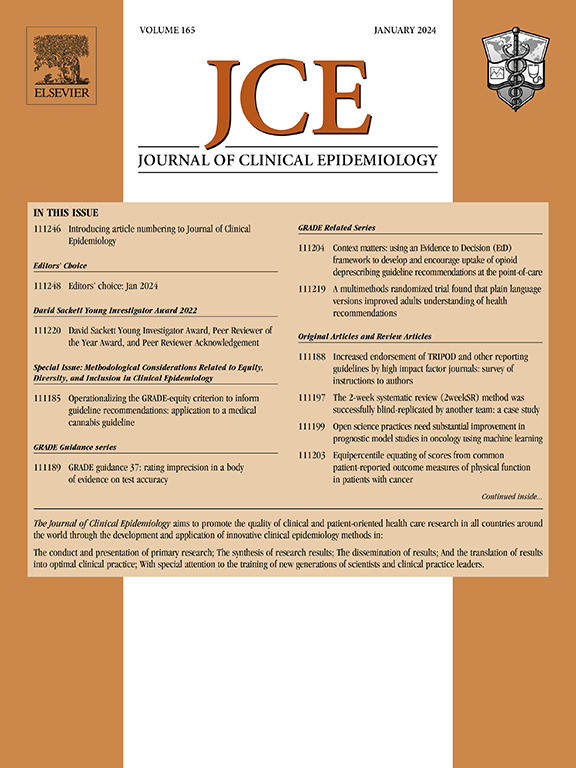对抗抑郁药物有很大的反应还是方法上的人为影响?STAR*D的二次分析,这是一项单臂、开放标签、非工业抗抑郁药物试验。
IF 5.2
2区 医学
Q1 HEALTH CARE SCIENCES & SERVICES
引用次数: 0
摘要
目的:重复Stone等人(2022)的研究发现,临床抗抑郁药试验的反应分布为大、中效和小亚组的三峰分布。方法:采用有限混合模型分析STAR*D研究1级(单臂、开放标签研究)汉密顿抑郁评定量表(HDRS)前后差异(n = 2184)。对于成功的复制,最佳拟合模型必须是三模态的,具有Stone等人的可比组件。二级/敏感性分析重复了对不同基线水平的抑郁严重程度、估算值和患者报告的抑郁症状的分析。结果:最佳拟合模型为双峰或三峰,但三峰解不符合复制标准。双峰模型一个分量的HDRS平均变化M = -13.0, SD = 6.7,包括65.3%的患者;另一个分量的HDRS平均变化M = -1.8, SD = 5.1,包括34.7%的患者。对于三模态模型,变化最大的分量(M = -14.3, SD = 6.4)适用于52%的患者,这与Stone等人的大效应分量(M = -18.8, SD = 5.1)适用于7.2%的患者有很大不同。二次/敏感性分析得出了类似的结论,对于患者报告的抑郁症状,最合适的模型是单峰或双峰模型。结论:该分析未能确定Stone等人报道的反应的三峰分布。除了难以用于监管目的之外,混合模型的结果不够可靠,无法取代比较治疗组之间抑郁评定量表得分平均差异的更稳健的方法。本文章由计算机程序翻译,如有差异,请以英文原文为准。
Large responses to antidepressants or methodological artifacts? A secondary analysis of STAR∗D, a single-arm, open-label, nonindustry antidepressant trial
Objectives
To replicate Stone et al's (2022) finding that the distribution of response in clinical antidepressant trials is trimodal with large, medium-effect, and small subgroups.
Methods
To apply finite mixture modeling to pre-post Hamilton Depression Rating Scale (HDRS) differences (n = 2184) of STAR∗D study's level 1, a single-arm, open-label study. For a successful replication, the best fitting model had to be trimodal, with comparable components as in Stone et al. Secondary/sensitivity analyses repeated the analysis for different baseline levels of depression severity, imputed values, and patient-reported depression symptoms.
Results
The best fitting models were either bimodal or trimodal but the trimodal solution did not meet criteria for replication. The bimodal model had 1 component with HDRS mean change of M = −13.0, SD = 6.7 and included 65.3% of patients, and another component with M = −1.8, SD = 5.1, 34.7%, respectively. For the trimodal model, the component with the largest change (M = −14.3, SD = 6.4) applied to 52% of patients, which differed substantially from the large effect component in Stone et al (M = −18.8, SD = 5.1), which applied to 7.2%. Secondary/sensitivity analyses arrived at similar conclusions, and for patient-reported depression symptoms the best fitting models were unimodal or bimodal.
Conclusion
This analysis failed to identify the trimodal distribution of response reported in Stone et al. In addition to being difficult to operationalize for regulatory purposes, results from mixture modeling are not sufficiently reliable to replace the more robust approach of comparing mean differences in depression rating scale scores between treatment arms.
求助全文
通过发布文献求助,成功后即可免费获取论文全文。
去求助
来源期刊

Journal of Clinical Epidemiology
医学-公共卫生、环境卫生与职业卫生
CiteScore
12.00
自引率
6.90%
发文量
320
审稿时长
44 days
期刊介绍:
The Journal of Clinical Epidemiology strives to enhance the quality of clinical and patient-oriented healthcare research by advancing and applying innovative methods in conducting, presenting, synthesizing, disseminating, and translating research results into optimal clinical practice. Special emphasis is placed on training new generations of scientists and clinical practice leaders.
 求助内容:
求助内容: 应助结果提醒方式:
应助结果提醒方式:


